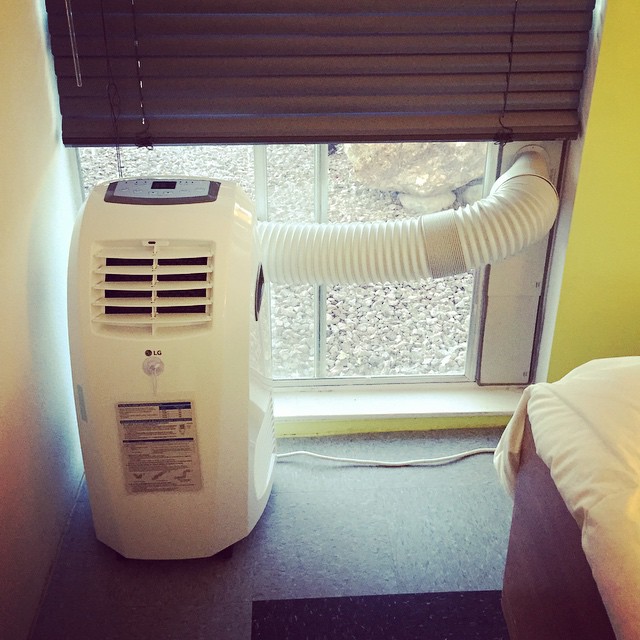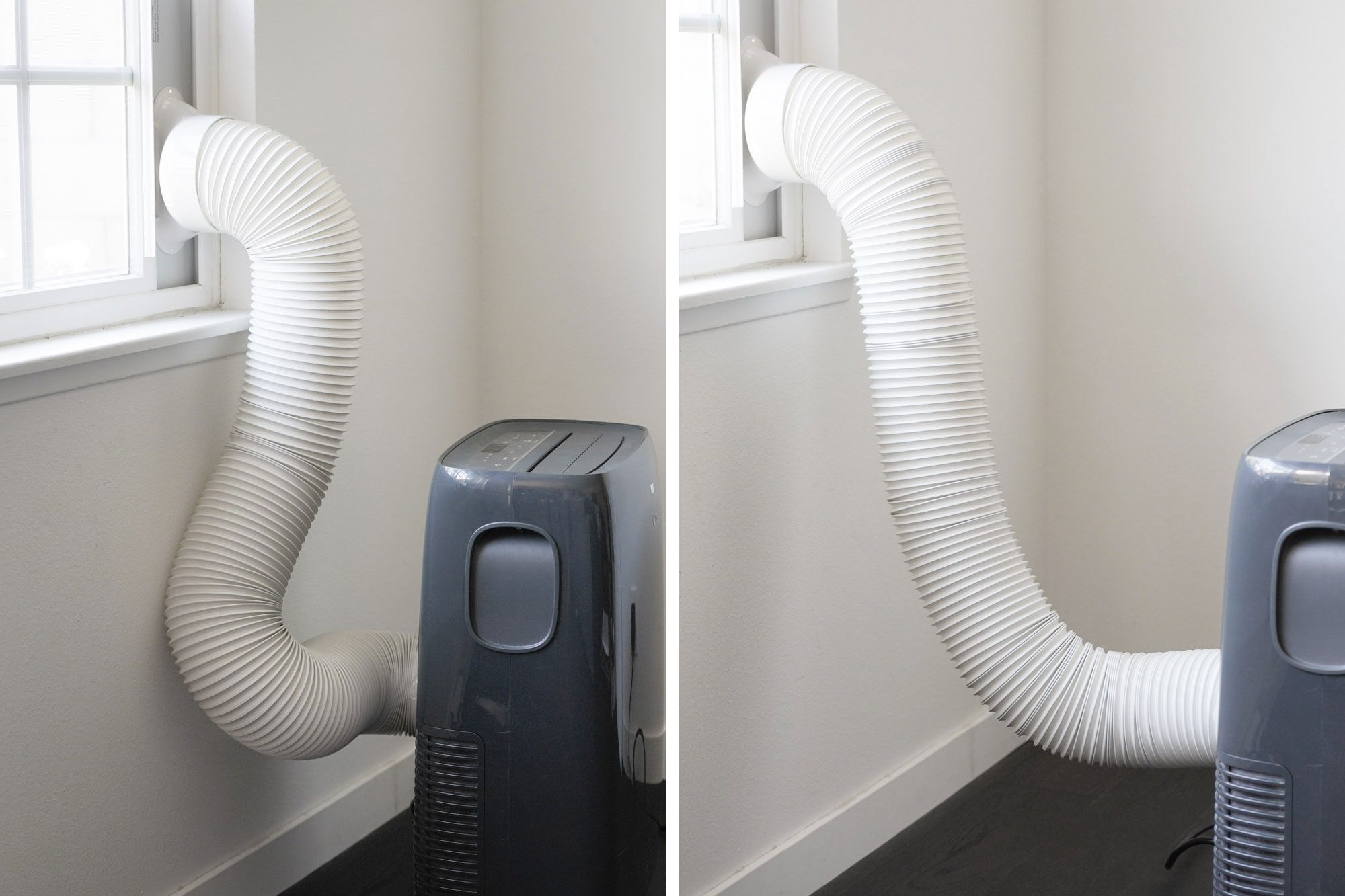Yes, all portable air conditioners require venting to properly remove heat and humidity from the room they are cooling. Portable air conditioners have become a popular option for cooling individual rooms or small spaces, offering flexibility and ease of use.
These portable units provide a convenient solution for areas that do not have central air conditioning systems or where window units are not suitable. However, before purchasing a portable air conditioner, it is important to understand one key requirement—they must be vented.
Venting allows these units to expel hot air and humidity generated during the cooling process. We will explore the importance of venting portable air conditioners, the different venting options available, and the benefits of proper venting for optimal cooling performance. So, let’s dive in and learn more about the necessity of venting portable air conditioners for efficient cooling.

Credit: americanhomewater.com
The Importance Of Ventilation For Portable Air Conditioners
Portable air conditioners require ventilation to effectively cool a room. Venting helps to expel warm air and moisture, allowing the unit to perform optimally and maintain a comfortable indoor environment. Without proper ventilation, a portable air conditioner may struggle to cool efficiently, resulting in decreased cooling performance.
Proper ventilation is crucial for optimal cooling efficiency of portable air conditioners. Ventilation plays a key role in removing heat and humidity from your space, ensuring a comfortable and healthy environment. Portable air conditioners work by extracting warm air from the room and cooling it through a refrigeration process. This process generates heat that needs to be expelled outside. Ventilation allows the hot air to be vented out, preventing the accumulation of heat inside the room and enabling the air conditioner to cool the space effectively.
Without proper ventilation, portable air conditioners may struggle to cool the room, resulting in inefficiency and reduced cooling performance. It is important to ensure that your portable air conditioner is properly vented to eliminate the heat generated during operation. Window kits or exhaust hoses can be used to vent the hot air outside through a window, wall, or ceiling. Clear, unobstructed ventilation pathways are essential for the air conditioner to function optimally and provide the desired cooling effect.
In summary, ventilation is vital for portable air conditioners to work efficiently, remove heat and humidity, and create a comfortable indoor environment.
How Portable Air Conditioners Work
Portable air conditioners work by cooling the air in a room through a simple process. These units consist of four main components:
- Compressor: responsible for pressurizing and cooling the refrigerant
- Condenser: releases the heat from the refrigerant to the outside environment
- Evaporator: absorbs the heat from the indoor air and cools it down
- Fan: circulates the cool air throughout the room
Proper ventilation is crucial to the operation of portable air conditioners. As they cool the air, they also produce heat as a byproduct. Without proper ventilation, the heat will accumulate in the room, making it uncomfortable and reducing the efficiency of the unit. This is why all portable air conditioners need to be vented.
Venting can be done through a window, sliding door, or a specially designed venting kit. This allows the hot air produced by the unit to be expelled outside, while the cooled air is circulated back into the room.
The Need For Ventilation In Portable Air Conditioners
Portable air conditioners, like their traditional counterparts, require proper ventilation to function optimally. Without adequate ventilation, these units can suffer from a decrease in performance and energy efficiency, limiting their overall effectiveness in cooling a space. Ventilation is necessary to disperse the warm air generated by the air conditioner’s cooling process, preventing it from recirculating back into the room and maintaining a comfortable indoor environment.
Inadequate ventilation can have a detrimental impact on the performance of a portable air conditioner. Without a proper venting setup, the unit may struggle to cool the room efficiently, resulting in longer cooling cycles and increased energy consumption. This can lead to higher electricity bills and potential wear and tear on the unit. It’s crucial to address common misconceptions that portable air conditioners can operate without the need for ventilation. While there are some portable models that utilize self-evaporative technology for condensation management, most still require proper venting to remove hot air from the room effectively.
Ventilation requirements may differ among portable air conditioner models, and it is important to follow the manufacturer’s guidelines. Some units may require a window installation kit, which includes a venting hose to exhaust the hot air outdoors. Others may require a floor-level vent or a through-the-wall venting setup. Proper installation is crucial to ensure efficient cooling and avoid potential damage to the unit. It is essential to understand the specifics of each portable air conditioner model and comply with the recommended ventilation requirements for optimal performance and longevity of the unit.
Various Ventilation Options For Portable Air Conditioners
Portable air conditioners provide a convenient and efficient way to cool a specific area, but it is important to properly vent the hot air they generate. One popular option for ventilation is through window kits. These kits are practical and widely-used, as they allow the warm air to be directed outside through a window opening.
To install a window ventilation kit, simply follow the instructions provided with the unit. Regular maintenance is key to keeping the kit functioning optimally. Periodically check for any leaks or blockages in the hoses, and ensure that the window seal is tight to prevent air leakage.
Window ventilation kits offer several benefits, such as easy installation and portability. However, there are also some drawbacks to consider, including potential security risks and limited window access.
Another option for venting portable air conditioners is through drop ceilings. This approach involves installing a vent in the ceiling and connecting it to the air conditioner using ducts. Before choosing this method, it is important to understand the installation process and consider factors such as the structural integrity of the ceiling and the availability of access points.
An alternative to traditional venting options is using a vent hose extension. This allows for more flexibility in unit placement and can extend the reach of the vent hose. However, it is important to be aware of potential limitations and considerations, such as increased air resistance and potential impact on cooling efficiency.
Alternatives To Traditional Ventilation Methods
Self-evaporative portable air conditioners have gained popularity as an alternative to traditional vented units. These models employ a unique technology that eliminates the need for an external vent. Instead, they use a process called self-evaporation to cool the air. Self-evaporation works by vaporizing the moisture collected during the cooling process and expelling it through the exhaust. This eliminates the need for manual drainage or the use of a condensate pump.
There are several pros and cons to consider with self-evaporative models. On the one hand, they offer convenience and portability, making them suitable for various applications. However, their effectiveness can be affected by high humidity levels, reducing their ability to cool the air effectively. Additionally, self-evaporative units may require regular maintenance to prevent clogs and ensure optimum performance.
Ventless portable air conditioners present another option for those seeking to avoid traditional ventilation methods. These units utilize advanced cooling technologies, such as evaporative cooling or refrigeration cycles, to cool the air without venting. While they do not require a vent, they may rely on other methods like misting or water-filled cooling pads to lower the temperature. Their effectiveness may vary depending on factors like room size, humidity levels, and ambient temperature.
It’s important to understand the technology behind ventless ACs and consider their limitations. Ventless units may struggle to cool larger spaces efficiently, and their cooling abilities may be influenced by environmental conditions. It’s crucial to assess your specific cooling needs and choose a portable air conditioner that aligns with your requirements.
Maintenance And Best Practices For Venting Portable Air Conditioners
When installing a portable air conditioner, venting is an essential aspect that cannot be overlooked. Venting helps remove the hot air generated by the unit and keeps the room cool and comfortable.
Cleaning and maintaining the vent hoses regularly is crucial to ensure efficient and proper functioning of the portable air conditioner. Use a vacuum or a brush to remove any debris or dust that may accumulate inside the hose. This will prevent clogs and allow for smooth airflow.
Checking for gaps in the vent hose is equally important. Any gaps can lead to the escape of cool air, thereby affecting the cooling efficiency of the unit. It is essential to ensure the vent hose is properly connected to both the air conditioner and the window exhaust kit to achieve an air-tight seal.
Proper ventilation is key to optimizing the cooling efficiency of a portable air conditioner. Be sure not to obstruct the airflow by placing objects near the unit or blocking the exhaust vent. Ensure there is enough space around the unit for proper air circulation.
| Tips for optimizing cooling efficiency through proper ventilation: |
|---|
| 1. Place the portable air conditioner near a window to easily exhaust the hot air. |
| 2. Use an insulating seal around the window kit to prevent hot air from entering the room. |
| 3. Keep the exhaust vent clear from any obstructions. |
| 4. Consider using a vent extension kit if the distance between the unit and the window is large. |
| 5. Regularly clean and maintain the air filters to ensure proper airflow and cooling efficiency. |
Conclusion (never In Heading Or Subheading)
The integral role of ventilation in portable air conditioners:
Portable air conditioners are a popular choice for cooling individual rooms or spaces. However, it is important to understand the integral role that ventilation plays in their operation. Ventilation is essential for the proper functioning of portable air conditioners as it allows for the expulsion of hot air generated during the cooling process.
Considerations for selecting the most suitable ventilation option:
| Ventilation Option | Advantages | Disadvantages |
| Window Venting | Easy installation, efficient cooling | Restricts window use, potential security concerns |
| Through-the-Wall Venting | No window obstruction, efficient cooling | Requires professional installation, permanent modification |
| Drop Ceiling Venting | Flexible installation, no window obstruction | May not be suitable for all room layouts |
Ensuring efficient cooling with proper maintenance and best practices:
Regular maintenance of portable air conditioners is crucial for maximizing their cooling efficiency. Some best practices include cleaning or replacing filters, inspecting and cleaning the exhaust hose, and ensuring proper sealing of windows or openings to prevent the ingress of warm air. By following these maintenance and best practices, users can enjoy optimal cooling performance and extend the lifespan of their portable air conditioners.
Frequently Asked Questions Of Do All Portable Air Conditioners Need To Be Vented
Do All Portable Air Conditioners Need To Be Vented?
No, not all portable air conditioners need to be vented. Some portable air conditioners are evaporative coolers that do not require venting, while others may have a self-evaporative feature that reduces the need for venting. However, most portable air conditioners still require venting to remove hot air and moisture from the room.
Conclusion
It is crucial to understand that all portable air conditioners require proper ventilation to function efficiently. Venting allows for the removal of hot air from the room, ensuring effective cooling. Whether it is through a window, venting kit, or another method, proper ventilation is necessary to prevent the unit from overheating.
Failing to vent the portable air conditioner correctly can lead to reduced cooling capacity and may even damage the unit over time. So, don’t forget to vent your portable air conditioner for optimal performance and longevity.


